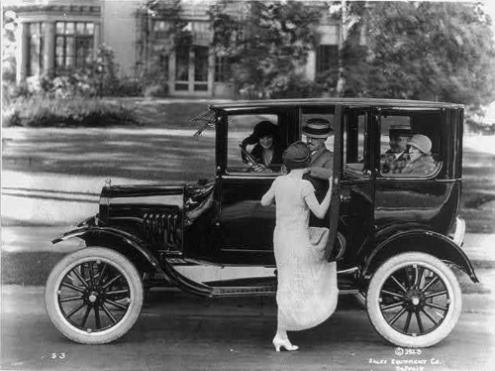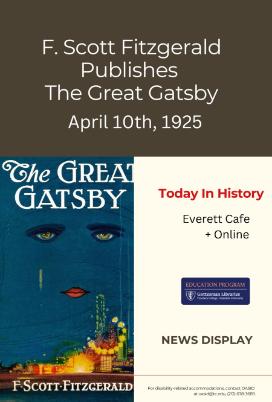Today In History: F. Scott Fitzgerald Publishes The Great Gatsby

And as I sat there brooding on the old, unknown world, I thought of Gatsby’s wonder when he first picked out the green light at the end of Daisy’s dock. He had come a long way to this blue lawn, and his dream must have seemed so close that he could hardly fail to grasp it. He did not know that it was already behind him, somewhere back in that vast obscurity beyond the city, where the dark fields of the republic rolled on under the night.
Gatsby believed in the green light, the orgastic future that year by year recedes before us. It eluded us then, but that's no matter—to-morrow we will run faster, stretch out our arms farther. . . . And one fine morning——
So we beat on, boats against the current, borne back ceaselessly into the past.”
-- F. Scott Fitzgerald, The Great Gatsby
Poetically written by F. Scott Fitzgerald and set on Long Island, near New York City during the Roaring Twenties, The Great Gatsby is one the most beloved works of American literature -- and one of most read novels in American high schools. From the viewpoint of Nick Carraway, a Yale alumnus and early career bond salesman, it explores several timeless themes: the Great American dream, society and class, love and marriage, materialism and morality. Nick is the neighbor of Jay Gatsby, a young, mysterious millionaire and former military officer from North Dakota who is long in love with Daisy, Nick's cousin and wife to Tom Buchanan.
The Great Gatsby was published 100 years ago today -- April 10th, 1925 -- and continues to invite reflection on the optical illusion of America, symbolized in the novel by the eyes of Dr. T. J. Eckleburg: a pair of faded, spectacled eyes painted as an adverstizement on a decrepit billboard overlooking the Valley of Ashes, industrial space between New York City and the wealthy fictional communities of East and West Egg. The iconic book cover, illustrated by Frances Cugat, a Barcelonan painter, shows the face of a Jazz Age flapper whose celestial eyes and lipsticked mouth hover over a dark blue skyline complete with twinkling lights and a ferris wheel that remind us of Coney Island.
Interestingly, The Great Gatsby received favorable reviews, but less successful sales than Fitzgerald's previous works, This Side of Paradise (1920) and The Beautiful and the Damned (1922), which were also published by Charles Scribner's Sons. F. Scott Fitzgerald's novels drew upon his romantic relationships, troubled marriage, and personal struggles, while they inspired film adaptations, fashion, and enduring interest in New York City.
The following articles are drawn from Proquest Historical Newspapers, which informs and inspires classroom teaching and learning.
- Ford, L. C. (1925, May 10). The Times Literary Page Books and Their Makers.: The Seamy Side of Society in "The Great Gatsby". Los Angeles Times (1923-1995)
- F. S. Fitzgerald, Jazz Age Novel Writer, Is Dead: Career of "Great Gatsby' Author Ends at 44. (1940, Dec 23). Chicago Daily Tribune (1923-1963)
- Starrett, V. (1954, Dec 12). 'The Best Loved Books': Fitzgerald's 'The Great Gatsby' Captures Feverish Atmosphere of Speakeasy Days. Chicago Daily Tribune (1923-1963)
- Scott, J. I., II. (1965, Dec 19). F. Scott Fitzgerald---A Taste of Hemlock: Fitzgerald. Los Angeles Times (1923-1995)
- Manning, M. (1971, Dec 13). Letters Show a Bit of F. Scott Fitzgerald: Deasr Scott--Dear Max: The Fitzgerald-Perkins Correspondence. Boston Globe (1960-)
- Livingstone, E. (1972, Dec 17). Great Gatsby! Chicago Tribune (1963-1996)
- Manning, M. (1981, Nov 29). F. Scott Fitzgerald: The Story of His Life Was the Story of His Marriage. Boston Globe (1960-)
- Giuliano, M. (1986, Sep 24). F. Scott Fitzgerald: Reassessing the Writer on 90th Anniversary of Birth. The Sun (1837-)
- Duggan, K. (2013, May 11). Gatsby's City Still Lives': Since F Scott Fitzgerald Immortalised Roaring Twenties New York, the City Has Changes Many Times Without Losing the Atmosphere That Captivates Millions. The Irish Times (1921-)
- Keating, S. (2013, May 25). The Great Gatsby: Don't Forget the Book: F Scott FitzGerald's Funeral Had a Meagre Attendance, But His Novel Gained a Reputation That Can't Be Overshadowed by Baz Luhrmann's New Film. The Irish Times (1921-)

Tips:
- Bryer, J. R., Prigozy, R., Stern, M. R., Balkun, M. M., Inge, M. T., Ames, C., Brodwin, S., Curnutt, K., Daniel, A. M., Dickstein, M., Gillin, E., Giltrow, J., Kehl, D. G., Kruse, H. H., Makowsky, V. A., Miyawaki, T., Nowlin, M., Prchal, T., Raubicheck, W., … Kruse, H. H. (Horst H. (2013). F. Scott Fitzgerald in the Twenty-First Century. (1st ed.). University of Alabama Press. e-book.
- Fitzgerald, F. S. (Francis S. (1988). The Great Gatsby (First Macmillan/Hudson River edition.). Macmillan. Stacks ; PS3511.I9 G7 1988
- Fitzgerald, F. S. (1945). The Great Gatsby F. Scott Fitzgerald ; Introd. by Lionel Trilling . New Directions Books. e-book.
- Fitzgerald, F. S. (Francis S., & Ibbotson, C. (2016). The Great Gatsby : Literature Kit Grades 9-12 (First edition.). Books on Demand. e-book.
- Kruse, H. H. (2014). F. Scott Fitzgerald at Work : The Making of “The Great Gatsby” (1st ed.). The University of Alabama Press. e-book.
- Tredell, N. (2007). Fitzgerald’s the Great Gatsby : A Reader’s Guide (1st ed.). Continuum. e-book.
Images:
- [Side View of a Ford Sedan with Four Passengers and a Woman Getting in on the Driver's Side.] Courtesy of Library of Congress Digital Collections.
- Poster Image: The Great Gatsby Cover 1925, Courtesy of Wikimedia Commons.
Need to keep current, look to the past, teach a topic? The Everett Cafe features daily postings of news from around the world, and also promotes awareness of historical events from an educational context. Be sure to check additional Cafe News postings on the library blog.

